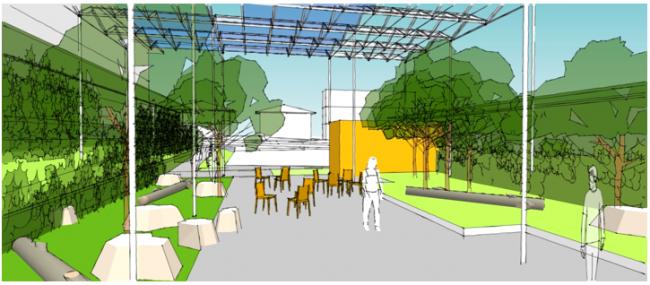Sunset Hill Substation designs unveiled
A view underneath the solar array in CAST Architecture's Big Roof Scheme for a possible power-generating park on the site of the former City Light substation on Sunset Hill.
Thu, 03/25/2010
On March 24, CAST Architecture presented three design schemes for the solar power-generating park neighborhood residents are hoping to build on the site of the former Sunset Hill City Light substation.
CAST Architecture's three designs were built around trying maximize the power-generating ability of the site without sacrificing community space as well neighborhood input from two previous meetings.
The Big Roof Scheme includes a 15-foot-high solar array covering the entire site, which is located on Northwest 65th Street and 32nd Avenue Northwest behind Ristorante Picolinos.
Dark solar panels would be spread out on the array to let light through. A central community plaza would be protected from rain by solar panels and glass panels.
There would be a community building in the southwest corner of the park and a storage shed in the northeast corner. Shade gardens would be located east and west of the central plaza.
The Pair Scheme is laid out much like the Big Roof Scheme, except there are two solar arrays, one in the northeast corner and one in the southwest corner, instead of one.
This scheme allows for the most solar panels without losing public space.
In the Wedge Scheme, the solar panels are packed together on one array in the center of the site. The array, 27 feet tall at its highest point, slopes toward the southeast corner and turns into a large staircase where the public can sit.
There is a covered plaza underneath the solar array. A community building underneath the stairs could open onto the plaza with garage-style doors.
All three schemes included seating, green space and a water feature.
The Big Roof Scheme is the most expensive, estimated at $775,000, followed by the Wedge Scheme at $730,000 and the Pair Scheme at $660,000.
Meeting attendees said they liked the Wedge Scheme for its flexibility of use, the Pair Scheme because it seemed open and inviting, and the Big Roof Scheme because it could allow for more solar panels.
Neighbors remained concerned over the relationship between the park and Picolinos, increased traffic in the adjacent alley, homeless people sleeping in the park and a lack of sight lines.
Despite the design process moving forward, the existence of the park is up in the air.
City Light owns the substation land. Typically in order for a park to be built there, Seattle Parks and Recreation would have to purchase the land from City Light, a cost that was not included in the estimated costs of the schemes.
By planning a park that would also generate enough solar energy to power two to three homes annually, residents are hoping City Light will allow the park to be built while maintaining ownership of the property.
CAST Architecture conducted a solar study of the site to figure out what its energy-generating potential is.
The study showed that the site has 90 to 98 percent solar access, which is very good and proof that it is a viable site for solar generation, said Forrest Murphy of CAST.
CAST will synthesize the ideas and feedback from the March 24 meeting into one design, which will be presented to the community in April.
In the meantime, neighborhood resident Dave Boyd is preparing an application for the Parks and Green Spaces Levy Opportunity Fund for the potential Sunset Hill substation park.
For more information and details on all three designs and to give feedback on them, visit the Sunset Substation Blog.


